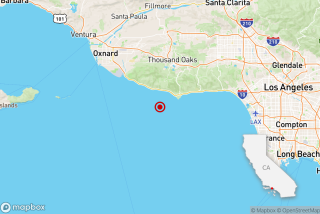Magnitude 4.5 Earthquake Jolts Mammoth Lakes Area
A magnitude 4.5 earthquake shook the Mammoth Lakes area of the Eastern Sierra for the second time in two weeks Monday, triggering another three-day low-level volcanic watch.
Altogether there were 32 temblors centered near Convict Lake, eight miles southeast of the town of Mammoth Lakes, over a seven-hour period, including shocks of 3.6, 3.3 and 3.0. Neither damage nor injuries were reported.
Town officials said only the two strongest quakes were felt in the city of several thousand residents and visiting skiers.
Scientists called the new quake sequence a little stronger than the one in the same vicinity that started Feb. 10 and marked a resumption of frequent quakes in the region after six quiet months.
The U.S. Geological Survey immediately changed the status of the area for the next 72 hours to “Level C” on the five-level volcanic warning system it established in 1990.
An “A” status indicates that an eruption is likely within hours to days. Level B indicates intense unrest with the volcano deforming rapidly and many earthquakes. Level C reflects strong unrest, Level D moderate unrest and Level E weak unrest or possible problems with recording instruments.
There have been three Level Cs in the last year, with no resulting volcanic activity, and David Hill, the Geological Survey scientist in charge of Mammoth geological monitoring, said new definitions are being considered.
Hill said Level C may soon be said to reflect only moderate rather than strong unrest. Hill also cautioned that only at Levels A and B is a volcanic “alert” declared.
Under a new color-coding system, Hill said everything Level C and lower will be referred to as the color green, Level B yellow, Level A orange, and a new classification, Level AA, reflecting an actual eruption, would be colored red.
There has been no volcanic activity near Mammoth Lakes in more than 200 years.
Hill and other scientists acquainted with Mammoth’s volcanic history said Monday that they cannot be certain whether the earthquakes of the last two weeks are related to volcanism.
Nearly all of them have occurred just south of the Long Valley caldera, an 18-by-12-mile crater left by catastrophic collapses and blasts 760,000 years ago that showered substantial ash all the way to the Middle West.
Hill said the quakes are occurring in a “transitional zone” between clearly volcanic quakes, relating to the movement of underground lava, that occur inside the caldera, and more conventional, tectonic quakes that occur farther south in what is known as the Sierran block.
Chris Farrar, another Geological Survey scientist monitoring the area, said that although an eruption is less likely outside the caldera, there are still volcanic cones outside the caldera.
Since four magnitude 6 earthquakes shook Mammoth Lakes in a two-day period in 1980, the Geological Survey has installed a broad array of seismometers, tiltmeters, pressure sensors and gas detectors throughout the area.
Carbon dioxide gas emissions on the side of Mammoth Mountain, west of the caldera, have killed trees and stirred concern since 1989, but Hill emphasized Monday that there has been little recent ground deformation that would intensify that concern.
Hill said that all signs are being carefully watched, including the periodic earthquakes.
More to Read
Sign up for Essential California
The most important California stories and recommendations in your inbox every morning.
You may occasionally receive promotional content from the Los Angeles Times.










